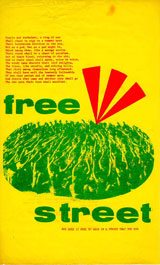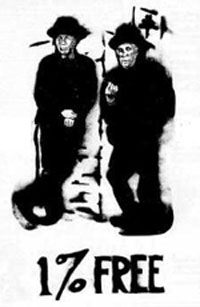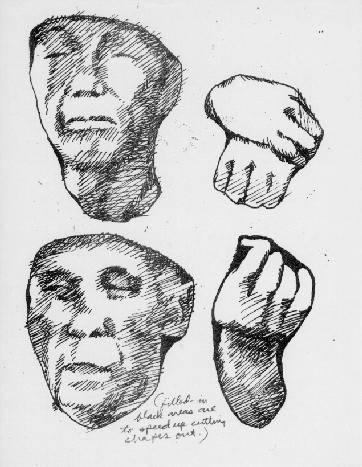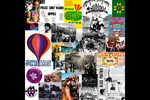Overview: who were (are) the Diggers?
The Digger Archives is an ongoing Web project to preserve and present the history of
the anarchist guerrilla street theater group that challenged the emerging Counterculture of
the Sixties and whose actions and ideals inspired (and continue to inspire) a generation
(of all ages) to create models of Free Association.
The Diggers were one of the legendary groups in San Francisco's Haight-Ashbury, one of
the world-wide epicenters of the Sixties Counterculture which fundamentally changed
American and world culture. Shrouded in a mystique of anonymity, the Diggers took their
name from the original English Diggers (1649-50) who had
promulgated a vision of society free from private property, and all forms of buying and
selling. The San Francisco Diggers evolved out of two Radical traditions that thrived in
the SF Bay Area in the mid-1960s: the bohemian/underground art/theater scene, and the New
Left/civil rights/peace movement.
The Diggers combined street theater, anarcho-direct action, and art happenings in their
social agenda of creating a Free City. Their most famous activities revolved around
distributing Free Food every day in the Park, and distributing "surplus energy"
at a series of Free Stores (where everything was free for the taking.) The Diggers coined
various slogans that worked their way into the counterculture and even into the larger
society — "Do your own thing" and "Today is the first day of the rest
of your life" being the most recognizable. The Diggers, at the nexus of the emerging
underground, were the progenitors of many new (or newly discovered) ideas such as baking
whole wheat bread (made famous through the popular Free Digger
Bread that was baked in one- and two-pound coffee cans at the Free Bakery); the first
Free Medical Clinic, which inspired the founding of the Haight-Ashbury Free Medical
Clinic; tye-dyed clothing; and, communal celebrations of natural planetary events, such as
the Solstices and Equinoxes.
First and foremost, the Diggers were actors (in Trip Without A Ticket, the term
"life actors" was used.) Their stage was the streets and parks of the
Haight-Ashbury, and later the whole city of San Francisco. The Diggers had evolved out of
the radicalizing maelstrom that was the San Francisco Mime Troupe which R.G. Davis, the
actor, writer, director and founder of the Troupe had created over the previous decade.
The Diggers represented a natural evolution in the course of the Troupe's history, as they
had first moved from an indoor milieu into the parks of the City, giving Free performances
on stages thrown up the day of the show. The Digger energy took the action off the
constructed platform and jumped right into the most happening stage yet — the streets
of the Haight where a new youth culture was recreating itself, at least temporarily, out
of the glaring eye of news reporters. The Diggers, as actors, created a series of street
events that marked the evolution of the hippie phenomenon from a homegrown face-to-face
community to the mass-media circus that splashed its face across the world's front pages
and TV screens: the Death of Money Parade, Intersection Game, Invisible Circus, Death of
Hippie/Birth of Free.
The Diggers broadcast these events, as well as their editorial comments of the day,
pronouncements to the larger Hip Community, manifestos and miscellaneous communications,
through broadsides and leaflets distributed by hand on Haight Street. These Web pages are
my attempt to present the story of the digger movement as it developed in the mid-to-late
sixties and early seventies (and evolved in various directions even to the present). I
have been collecting this Archive for forty years, and see the Web as a way to display
the materials and make them available both for researchers and for all diggers past and
present who want to preserve and participate in this
history. |
 An
issue of the Free City News street sheets distributed in San Francisco,
1967-68.

Shown above is the "1% Free" poster that first appeared as wall sized
posters in the Winter of 1968 and became a Digger trademark for the last
cycle of street events. Various interpretations of the poster's cryptic symbology
evolved. One interpretation which gained a certain infamy/popularity was
that merchants and rock bands were expected to contribute 1% of their receipts to the
Free
City Bank to fund various activities such as the Free Food Distribution
system.

Heads and hands of the Tong Warriors, 8-1/2" x 11" stencil used as cut-out in
production of the original 1% Free poster (early 1968.)
|

